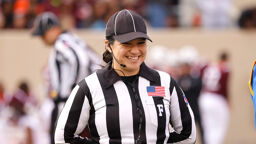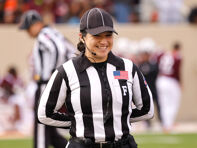Thirty-seven words are all that stand between those who fight for equality and those who champion discrimination.
They are the words of a federal law known as Title IX of the Education Amendments of 1972, enacted 48 years ago:
“No person in the United States shall, on the basis of sex, be excluded from participation in, be denied the benefits of, or be subjected to discrimination under any education program or activity receiving Federal financial assistance.”
We’re sharing this because almost five decades later, sex discrimination in schools is still a battleground. This is especially evident following last week’s historic ruling by the U.S. Supreme Court that found it is illegal to discriminate against gay and transgender American workers because of how they identify or whom they love — and we believe that also includes anyone identifying as LGBTQ+.
Get off the sidelines and into the game
Our weekly playbook is packed with everything from locker room chatter to pressing LGBTQ sports issues.
While the ruling only applies to the workplace, it’s anticipated to be utilized to argue discrimination in all forms should be illegal when it comes to gender identity and sexual orientation. And that includes sports.
One of the most crucial things about Title IX that is misunderstood: “Title IX benefits everyone — girls and boys, women and men,” according to the leading national collegiate sports organization, the NCAA.
Below this 2012 video retrospective from the Obama White House, you’ll find how the NCAA views both Title IX and transgender athletes. Bookmark this page for future reference to this fight for equality.
Questions and Answers from the NCAA about Title IX:
Q. Who does Title IX apply to?
Title IX applies to all educational institutions, both public and private, that receive federal funds. Almost all private colleges and universities must abide by Title IX regulations because they receive federal funding through federal financial aid programs used by their students.
Q. How is Title IX applied to athletics?
Athletics programs are considered educational programs and activities. There are three basic parts of Title IX as it applies to athletics:
- Participation: Title IX requires that women and men be provided equitable opportunities to participate in sports. Title IX does not require institutions to offer identical sports but an equal opportunity to play;
- Scholarships: Title IX requires that female and male student-athletes receive athletics scholarship dollars proportional to their participation; and
- Other benefits: Title IX requires the equal treatment of female and male student-athletes in the provisions of: (a) equipment and supplies; (b) scheduling of games and practice times; (c) travel and daily allowance/per diem; (d) access to tutoring; (e) coaching, (f) locker rooms, practice and competitive facilities; (g) medical and training facilities and services; (h) housing and dining facilities and services; (i) publicity and promotions; (j) support services and (k) recruitment of student-athletes.
Q. Does Title IX apply only to athletics?
Although it is the application of Title IX to athletics that has gained the greatest public visibility, the law applies to every single aspect of education, including course offerings, counseling and counseling materials, financial assistance, student health and insurance benefits and/or other services, housing, marital and parental status of students, physical education and athletics, education programs and activities, and employment.
Q. How does an institution comply with Title IX?
An institution must meet all of the following requirements in order to be in compliance with Title IX:
- For participation requirements, institutions officials must meet one of the following three tests. An institution may:
- Provide participation opportunities for women and men that are substantially proportionate to their respective rates of enrollment of full-time undergraduate students;
- Demonstrate a history and continuing practice of program expansion for the underrepresented sex;
- Fully and effectively accommodate the interests and abilities of the underrepresented sex; and,
- Female and male student-athletes must receive athletics scholarship dollars proportional to their participation; and,
- Equal treatment of female and male student-athletes in the eleven provisions as mentioned above.
Q. Does Title IX benefit only girls and women?
Title IX benefits everyone — girls and boys, women and men. The law requires educational institutions to maintain policies, practices and programs that do not discriminate against anyone on the basis of gender. Elimination of discrimination against women and girls has received more attention because females historically have faced greater gender restrictions and barriers in education. However, Title IX also has benefited men and boys. A continued effort to achieve educational equity has benefited all students by moving toward creation of school environments where all students may learn and achieve the highest standards.
Q. Who is responsible for enforcing Title IX?
Institutions are responsible for complying with federal laws. The Office for Civil Rights (OCR) of the U.S. Department of Education enforces Title IX. OCR has the authority to develop policy on the regulations it enforces. In regard to athletics programs, OCR developed an Intercollegiate Athletics Policy Interpretation that was issued December 11, 1979. The 1979 Policy Interpretation remains current policy. On April 2, 1990, OCR issued an athletics policy document called “Title IX Athletics Investigator’s Manual” that has assisted athletics departments with enforcement and compliance issues with Title IX. Anyone may file an OCR complaint, and the identity of the party who files the complaint will be kept confidential.
Q. How is Title IX compliance assessed?
Title IX compliance is assessed through a total program comparison. In other words, the entire men’s program is compared to the entire women’s program, not just one men’s team to the women’s team in the same sport. The broad comparative provision was intended to emphasize that Title IX does not require the creation of mirror image programs. Males and females can participate in different sports according to their respective interests and abilities. Thus, broad variations in the type and number of sports opportunities offered to each gender are permitted.
Q. Does Title IX require that equal dollars be spent on men and women’s sports?
No. The only provision that requires that the same dollars be spent proportional to participation is scholarships. Otherwise, male and female student-athletes must receive equitable “treatment” and “benefits.”
Q. Why does Title IX not require the same amount be spent on men and women’s sports?
The Javits Amendment stated that legitimate and justifiable discrepancies for nongender related differences in sports could be taken into account (i.e., the differing costs of equipment or event management expenditures). A male football player needs protective equipment such as pads and a helmet, and a female soccer player needs shin guards. Title IX does allow for a discrepancy in the cost of the equipment as long as both the football and soccer player received the same quality of equipment. However, a female ice hockey player must receive the same protective equipment that a male ice hockey player would receive, inasmuch as the protective equipment is the same.
Q. Does Title IX require identical athletics programs for males and females?
Title IX does not require identical athletics programs for males and females. Rather, Title IX requires that the athletics programs meet the interests and abilities of each gender. Under Title IX, one team is not compared to the same team in each sport. OCR examines the total program afforded to male student-athletes and the total program afforded to female student-athletes and whether each program meets the standards of equal treatment. Title IX does not require that each team receive exactly the same services and supplies. Rather, Title IX requires that the men and women’s program receive the same level of service, facilities, supplies and etc. Variations within the men and women’s program are allowed, as long as the variations are justified.
Q. Is any sport excluded from Title IX?
Under Title IX there are no sport exclusions or exceptions. Individual participation opportunities (number of student-athletes participating rather than number of sports) in all men’s and women’s sports are counted in determining whether an institution meets Title IX participation standards. The basic philosophical underpinning of Title IX is that there cannot be an economic justification for discrimination. The institution cannot maintain that there are revenue productions or other considerations that mandate that certain sports receive better treatment or participation opportunities than other sports.
Q. Does Title IX mandate that a decrease in opportunities for male athletes be made in order to provide an increase in opportunities for female athletes?
Title IX does not require reductions in opportunities for male student-athletes. One of the purposes is to create the same opportunity and quality of treatment for both female and male student-athletes. Eliminating men sports programs is not the intent of Title IX. The intent of Title IX is to bring treatment of the disadvantaged gender up to the level of the advantaged group.
Q. Is there someone at my institution who would know about Title IX?
Compliance with Title IX is a shared responsibility of an entire institution, from top-level administration to individual staff members. Title IX mandates that institutions or other recipients of federal funds designate at least one employee as a Title IX coordinator to oversee compliance efforts. Institutions also are required to investigate any complaints of gender discrimination. In addition, all students and employees must be notified of the name, office address and telephone number of the designated Title IX coordinator. A student-athlete who has questions about Title IX specific to the their institution may find the following individuals on their campus a good resource: (1) senior woman administrator; (2) director of athletics; (3) faculty athletics representative; (4) compliance coordinator; (5) the legal council; or (6) Equal Employment Opportunities office.
Q. How do I know if my institution is in compliance with Title IX?
You just need to ask. It has become easier for anyone to find out if an institution is in compliance with Title IX. In 1994, the U.S. Congress passed the Equity in Athletics Disclosure Act, which requires all colleges and universities to report each year on athletics participation numbers, scholarships, program budgets and expenditures, and coaching salaries by gender. Information may be obtained by contacting your institution’s athletics department and requesting this information. The results are identified by gender, and a reader may use this information to assist in assessing an institution’s compliance with Title IX.
NCAA Statement on discrimination of transgender student athletes:
Federal, state, and local laws prohibit discrimination on the basis of gender identity/expression. In addition, many K-12 and collegiate educational institutions have adopted non-discrimination policies that include gender identity/expression. Each school or school district should be knowledgeable about specific legal requirements that apply and make sure that all school athletic staff understand their responsibilities to abide by and enforce these laws.
Federal Protections
Title IX of the Education Amendments of 1972 — The purpose of Title IX is to address sex discrimination in schools. This federal law also addresses discrimination or harassment in schools based on gender stereotypes. As described by the Department of Education’s Office for Civil Rights guidance in 2010, when gender non-conforming or transgender students are targeted on the basis of their gender expression, Title IX may provide the basis for legal recourse. Schools are responsible for developing educational programs, preventative policy and grievance procedures to address sexual harassment, bullying and assault. The Obama administration issued these recommendations to schools in 2016; the Trump administration rescinded that guidance in 2017.
Equal Protection Clause of the Fourteenth Amendment of the United States Constitution
The Equal Protection clause states that “no state shall … deny to any person within its jurisdiction the equal protection of the laws.” Several successful cases involving allegations of harassment and discrimination against lesbian, gay, bisexual, and transgender students and staff in public schools have been based on the Equal Protection clause.
The American Bar Association (ABA) opposes discrimination against those who are transgender or gender non-conforming. The ABA is a national organization of lawyers, law students and judges, and is the largest voluntary professional association in the world, with more than 400,000 members. The control and administration of the ABA is vested in the House of Delegates, which is the policy-making body of the Association.
In 2006, the ABA House of Delegates adopted a recommendation that all federal, state, local, and territorial governments enact legislation prohibiting discrimination on the basis of actual or perceived gender identity or expression, in employment, housing, and public accommodations. For more, click here.
For a list of what Campus Pride calls “the worst campuses for LGBT youth, click here.







































